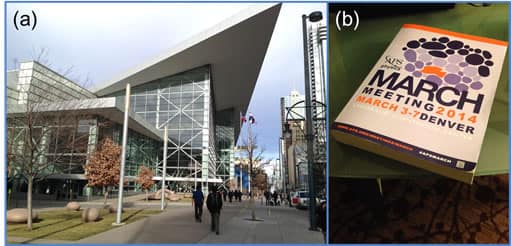APS March Meeting Tomohiro Tetsumoto
Research
APS MARCH MEETING 2014 Conference Participation Report
Tomohiro Tetsumoto, 2nd year master student, Tanabe Laboratory
[Society Overview].
The APS March Meeting is a very large conference with more than 10,000 attendees organized by the American Physical Society, which publishes the Physical Review series. Topics covered include materials, optics, electronics, spintronics, environment, nanotechnology, and more. However, as is typical of Physical Review, the conference focused on basic physics rather than applications. Invited speakers included Dr. Vuckovic of Stanford University and Dr. Lukin of Harvard University, as well as Dr. Painter of Caltech (now Max Plunck Institute), who attended the conference last year. All of them seem to like the Quantum~ topic. The research level of the topics discussed at the conference ranged from world-class presentations by the above-mentioned speakers to those by under graduate students (there was a dedicated session for undergraduates). The venue was full of energy with a variety of researchers from various fields gathered in one place.

(b) The program of the conference (abstracts are only available in electronic media). The thickness of the program shows the scale of the conference.
[regarding his own presentation].
I would like to report on some of the research that caught my attention at the conference.
Micro-tweezers for studying vibrating carbon nanotubes
Lipson was jointly named in the presentation. They fabricated carbon nanotubes as mechanical resonators and confirmed strong optomechanical coupling with disk-shaped optical resonators. Apparently, the last author, Mceuen of Cornell University, is an expert on carbon-based materials. His research on carbon nanotubes and graphene has been widely published in Nature and Science. He says that the advantage of carbon nanotube mechanical resonators is that their vibration modes are very flexible, and they are expected to be used as sensors because they are sensitive to external forces. He also mentioned that fabrication methods have been difficult in the past, and claimed that the new method combines lithographic fabrication of the jig part and selective growth of carbon nanotubes by the CVD method, making it easy to fabricate. Although the presentation was limited to the evaluation of the performance of carbon nanotubes as mechanical resonators and the confirmation of their coupling with optical resonators, it is noteworthy that Lipson has been involved in research on carbon-based materials, as he has conducted several pioneering studies in optomechanics.
Plasmonic and Photonic Lasers Based on Semiconductor Nanowires: Low-loss and High Mode-tunablity
Presentation by Sum Tze Chien group of Nanyang Technological University, Singapore. The presentation is about lasing using nanowire resonators. The new method enables a drastic modulation of the oscillation wavelength (mode change) in the range beyond 30 nm, which is difficult to achieve by electrical bandwidth tuning, and achieves ultraviolet (370 nm) oscillation at a low threshold of 3.5 MW/cm2 at room temperature for the first time in plasmonic lasers.
The new method seems to be basically just changing the length of the nanowires. The longer the nanowire, the more the oscillation wavelength red-shifts. It seems that the increase of the propagation distance increases the loss and absorption of exciton polaritons and changes the length of the Urbach tail corresponding to the laser oscillation position. There are about three other effects involved in the paper, but I don't want to explain them because I don't understand them well. However, all of them are self-absorption effects, not external modulations. As for the ultraviolet oscillation, it seems that the thickness of the nanowires is made thinner to increase the energy density, thereby enabling oscillation. I found it interesting that the wavelength of oscillation can be greatly adjusted simply by changing the structure of the nanowires.
According to the biography on their website, the current research group was established around 2008 and started publishing papers in 2010 (before that, they were doing femtosecond laser spectroscopy?) The group started publishing papers in 2010 after 2 years of preparation. The momentum has been great since 2010, after 2 years of preparation.
Hybrid metal-dielectric nanocavity for ultrafast quantum dot optical field interaction.
Photonic Crystal Cavities in Cubic (3C) Silicon Carbide
Both are the work of vuckovic's group at Stanford. In the first presentation, the strong light-matter coupling was achieved by using dielectric (InGaAs) nanopillars with InAs quantum dots covered with a metal (Ag). The Q value as a resonator is low (Q ≈ 25), but the mode volume is very small (V ≈ 0.04 (λ/n)3). The coupling coefficient is g/2π ≈ 150-200 GHz, which is about 10 times higher than the coupling between photonic crystals and quantum dots. He also mentioned that the hybrid pillar may be able to be used for experiments at room temperature, whereas photonic crystals require cooling during experiments.
The second one is about the fabrication of photonic crystals using SiC, and although the performance is not good at present because of Q = 800, SiC has many advantages such as material nonlinearity and ease of fabrication. Personally, I had only considered SiC to be thermally resistant and had a prejudice that SiC is difficult to fabricate because it contains carbon, but I felt the need to look into it again. Since there were many presentations in different fields at the conference, I heard many names of unfamiliar materials such as W and Mo, but it might be good to review the physical properties of semiconductor-related materials.
What I felt through the two presentations was the need to keep an antenna for new structures and materials. I have the impression that laboratories with strong research capabilities are actively conducting research using new structures and materials. I think this is because they are always aware of problems in current research. While it is not possible to conduct interesting research simply by following trends, I would like to follow the awareness of people in the world about the problems they are facing.
- Categories
- 国際会議報告



